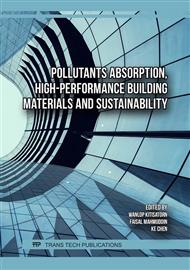[1]
M. Vail, C. Zhu, C.-S. Tang, N. Maute, and M. T. Montalbo-Lomboy, "Desiccation Cracking Behavior of Clayey Soils Treated with Biocement and Bottom Ash Admixture during Wetting–Drying Cycles," Transp Res Rec, vol. 2674, no. 8, p.441–454, 2020.
DOI: 10.1177/0361198120924409
Google Scholar
[2]
G. Kannan, B. C. O'Kelly, and E. R. Sujatha, "Geotechnical investigation of low plasticity organic soil treated with nano-calcium carbonate," Journal of Rock Mechanics and Geotechnical Engineering, vol. 15, no. 2, p.500–509, Feb. 2023.
DOI: 10.1016/j.jrmge.2022.05.004
Google Scholar
[3]
P. Jamsawang, B. Adulyamet, P. Voottipruex, P. Jongpradist, S. Likitlersuang, and K. Tantayopin, "The free swell potential of expansive clays stabilized with the shallow bottom ash mixing method," Eng Geol, vol. 315, p.107027, 2023.
DOI: 10.1016/j.enggeo.2023.107027
Google Scholar
[4]
M. K. Burhanudin, M. H. W. Ibrahim, R. P. Jaya, and B. S. Umniati, "Characterisation of Ground Coal Bottom Ash With Different Grinding Times," International Journal of Sustainable Construction Engineering and Technology, vol. 14, no. 3, p.49–56, 2023.
Google Scholar
[5]
V. Sharma and S. Singh, "Modeling for the use of waste materials (Bottom ash and fly ash) in soil stabilization," Mater Today Proc, vol. 33, p.1610–1614, 2020.
DOI: 10.1016/j.matpr.2020.05.569
Google Scholar
[6]
ASTM D2166: Standard Test Method for Unconfined Compressive Strength of Cohesive Soil, West Conshohocken, PA, United States.
Google Scholar
[7]
ASTM D3967: Standard Test Method for Splitting Tensile Strength of Intact Rock Core Specimens with Flat Loading Platens, West Conshohocken, PA, United States.
DOI: 10.1520/d3967-16
Google Scholar
[8]
C. Phutthananon, N. Tippracha, P. Jongpradist, J. Tunsakul, W. Tangchirapat, and P. Jamsawang, "Investigation of Strength and Microstructural Characteristics of Blended Cement-Admixed Clay with Bottom Ash," Sustainability, vol. 15, no. 4, p.3795, 2023.
DOI: 10.3390/su15043795
Google Scholar
[9]
T. Chompoorat, S. Likitlersuang, T. Thepumong, W. Tanapalungkorn, P. Jamsawang, and P. Jongpradist, "Solidification of sediments deposited in reservoirs with cement and fly ash for road construction," International Journal of Geosynthetics and Ground Engineering, vol. 7, no. 4, p.85, 2021.
DOI: 10.1007/s40891-021-00328-0
Google Scholar
[10]
T. M. Le, L. C. Dang, and H. Khabbaz, "Strength characteristics of lime and bottom ash reinforced expansive soils," in Eighth International Conference on Case Histories in Geotechnical Engineering, American Society of Civil Engineers Reston, VA, 2019, p.352–362.
DOI: 10.1061/9780784482117.036
Google Scholar
[11]
P. Jamsawang, H. Poorahong, P. Jongpradist, S. Likitlersuang, and S. Chaiyaput, "Destructive and nondestructive characteristics of solidified reservoir sediments incorporating microstructural analyses," Bulletin of Engineering Geology and the Environment, vol. 81, no. 8, Aug. 2022.
DOI: 10.1007/s10064-022-02797-7
Google Scholar
[12]
N. Yoobanpot, P. Jamsawang, H. Poorahong, P. Jongpradist, and S. Likitlersuang, "Multiscale laboratory investigation of the mechanical and microstructural properties of dredged sediments stabilized with cement and fly ash," Eng Geol, vol. 267, p.105491, 2020.
DOI: 10.1016/j.enggeo.2020.105491
Google Scholar



